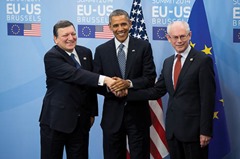Free trade across the Atlantic?
 agendaNi summarises the main details of the proposed EU-US trade deal.
agendaNi summarises the main details of the proposed EU-US trade deal.
The Transatlantic Trade and Investment Partnership (TTIP) is a potential free trade agreement covering the EU and USA. Talks were officially launched at the Lough Erne G8 summit last July and while no timescale has been outlined, the agreement may completed by the next European Parliament election in 2019.
Supporters of TTIP claim that it would increase European GDP by 0.5 per cent each year (up by €119 million) and therefore boost the average European household by €545 per year. The figures have been estimated by the London-based Centre for Economic Policy Research.
The negotiating teams are led by Ignacio Garcia Bercero, representing the European Commission, and Assistant US Trade Representative Dan Mullaney. Other key representatives include the ambassadors on each end of the EU-US relationship: João Vale de Almeida and Anthony Gardner respectively.
The EU maintains that it will not lower its environmental and labour standards, which suggests that the two sides will agree to disagree where they cannot find a consensus. Farming may be a difficult area as some American food processing techniques and genetic modified products are not permitted in Europe.
Negotiators are working to a three-fold remit: market access, regulatory issues, and responding to global challenges.
The removal of tariffs on industrial and agricultural products is the key goal in market access. These tariffs are low at any rate (generally 3-5 per cent) but add considerable costs for big businesses which handle large trade volumes.
Service markets will also be opened up, with transport and public procurement being earmarked as particular areas for reform. Trade unions claim that the investor-state dispute settlement clause will allow corporations to successfully challenge governments and lead to increased competition for public services.
Regulation is the area where the largest economic gains have been identified. These often add more costs than tariffs but include important health and safety standards, especially for food products. Negotiators will also aim to standardise the rules in the health technology, pharmaceutical, ICT and automotive sectors. They envisage a ‘living agreement’ which can be amended over time as new barriers arise.
On the global challenges, the EU and USA both consider their intellectual property regimes to be efficient. They plan to focus on specific areas where IP law diverges rather than harmonise the two systems. The two sides want to make sure that any deal is ‘fit for purpose’ in a 21st century economy. The final agreement would need to be approved by the European Parliament and the EU member states, represented on the European Council.
As expected, conservative parties are more supportive of TTIP whereas the left is sceptical. Sinn Féin has already rejected TTIP but UUP MEP Jim Nicholson is reserving judgement until more detail is available.
The rise of Euro-scepticism may also become a complicating factor as voters are increasingly demanding that their national interests are protected. Furthermore, if the UK left the EU, it may lose out on any benefits from the deal.
Britain would find itself in a similar position to Norway which only has an indirect input into the talks. Norwegian Europe Minister Vidar Helgesen has said that TTIP is a challenge for his country. The talks “have direct and substantial consequences for us” but there is no guarantee that its views are heard at the negotiating table.
Regular updates on TTIP are available at ec.europa.eu/trade





